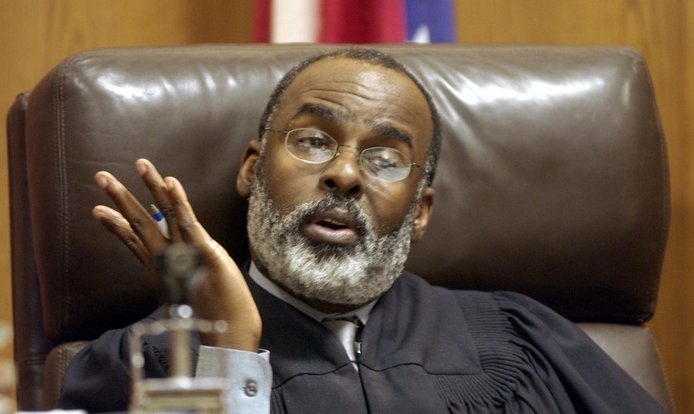Monday, October 26, 2020
Your Supreme Court of Ohio Questions Answered

by The Honorable Ronald Adrine, Jurist-in-Residence, Cleveland-Marshall College of Law, and Retired Judge, Cleveland Municipal Court
On October 19, the City Club and the Ohio Debate Commission (ODC) presented a forum featuring three distinguished judges discussing the future of the Supreme Court of Ohio. During that forum, we received many audience questions. We couldn’t fit all the questions into the hour-long forum, however, Judge Adrine took the time to provide answers to all the audience questions that were submitted.
1. Given that the Ohio Supreme Court, in deciding cases as the highest court in the state, sets policy, isn't it a fiction to say that the justices decide cases based on merely the facts and the law?
Ohio Supreme Court Justices take an oath, as do all other Ohio lower court judges, that requires them to, “…administer justice without respect to persons, faithfully and impartially…” It is safe to say that all who take that oath do so honestly, solemnly and seriously. It is disingenuous to believe, however, that judges are never conflicted. The interests of donors, for instance, may clash with the facts and/or the law in a given case. When that happens, hard decisions must be made. In most cases, the policy decisions of Justices are consistent with their assessment of the facts, to which they then apply their interpretation of the law. Most, upon determining that their legal interpretation conflicts with their personal interest to such degree that it would cause them to be unfair, will recuse themselves.
The harder cases occur when a policy conflict is less clear. Justices are human. When the call is discretionary because the law and/or the facts are not clear but lean slightly against one’s own proclivities and those of a benefactor, it is not unreasonable to think that one might be tempted to not to recognize the conflict.
That said, it is safe to say that in the vast majority of policy decisions handed down by the justices of the Ohio Supreme Court to all other judges in Ohio, their oaths are followed and their decisions are consistent with their independent view of the facts and the law. They attempt to consistently avoid not only impropriety but even the appearance of impropriety, as the Code of Judicial Conduct requires. In other words, they are who they were when the presented themselves for election. That’s why it is so important that the electorate educate themselves as to who these people are before they give them the authority to make policy decisions that affect us all.
2. I’m curious to hear what the panelists thought of the Ohio Business Roundtable’s efforts to encourage support of the incumbents.
Employers have the right to encourage those who work for them to vote and support individuals who those employers believe will further their interests. Therefore, the Ohio Business Roundtable’s efforts to encourage support of incumbent Ohio Supreme Court Justices is protected speech under the U. S. Constitution. As long as the encouragement is not overtly coercive, it is not unreasonable for the Business Roundtable to ask employees to support Ohio Supreme Court candidates with the expectations that, once elected, those justices will be more favorable to their employer’s interests than their opponents.
3. Please ask about strict constructionists who say they depend on what the founders meant 250 years ago. The country has changed so much.
“Strict constructionist,” “Originalists,” and “Textualists” all, to one degree or another, believe that interpretation of the Constitution in the 21stCentury should be limited to the language of the document as written and/or understood when it was adopted in the 18thCentury. The genius of the U.S. Constitution is its simplicity. The Framers understood that it was impossible for them to anticipate how governing would evolve over the eons. So, for instance, the U.S. Constitution’s Article III, dealing with the Judiciary has only three sections, while the Ohio State Constitution has 22. The Constitution was designed to be vague and subject to interpretations that could accommodate the needs of an evolving nation. Strict construction “straight-jackets” that accommodation.
4. Ohio holds more prisoners than all of Cuba, roughly same population, and maintains a higher rate of incarceration. Meanwhile a supermajority of Ohio Supreme Court has taken money from FirstEnergy, a company under federal indictment for racketeering. How do judges so cleanly escape scrutiny for the corruption and misery they participate in?
Every two years, members of the Ohio Supreme Court are on the ballot. The people have the ability to hold the elected judiciary accountable. Although nearly 1,000,000 fewer voters cast ballots in Ohio Supreme Court races than voted for President in 2016. It is clear, therefore, that a significant number of the people are uninformed and apathetic when it comes to the court and, choose to voluntarily waive their right to scrutinize or criticize what it does.
5. Many local bar Associations survey members about judicial candidates. Is this a conflict? Is this helpful or informative?
Far from being a conflict, surveys conducted by local bar associations of their members concerning their views of candidates running for judicial office, do the community a service. Lawyers, more than any other segment of society, are most likely to have first-hand experience with those on the bench and those who aspire to it. Therefore, their collective opinions of a candidate’s knowledge of the law, temperament, industry, efforts to improve the administration of justice, fairness, punctuality, grounded-ness, etc., are more likely to be informed. At least, those surveys are helpful in providing people who never get into a courthouse, some insight into how a candidate is perceived by those who work closest to them or who are most likely to be privy to those who do.
6. Is Ohio served or dis-served by the mandatory retirement age for Ohio judges?
Yes and no. Many of the judges who have reached the age of 70 in 2020 still are physically and mentally able to continue to serve. To paraphrase an old African proverb, “when an old judge leaves the bench, a library burns to the ground!” While this is not true of everyone, it is true of many. Years of irreplaceable experience and knowledge is lost every time a judge retires after decades on the bench. The current law was designed at a time when people over 70 were more likely to become infirm. Today, the statute “throws the baby out with the bath.”
7. Electing our judiciary is fundamental to our system of justice. Rather than, as Judge Adrine suggests, eliminate elections for judges, could we revamp the electoral process to provide better, clearer, thorough information for an educated election process?
In a perfect world, the election of judges would be the ideal. Unfortunately, we do not live in a perfect world. It is fair to say that the majority of the electorate do not have the functional knowledge to make informed decisions as to who should be on the bench and who should not. Considerations such as name, gender, race, politics, finance, patronage all totally overwhelm considerations of temperament, scholarship, intelligence, and diligence. Also unfortunate is the fact that we, as a society, are unwilling to devote the resources necessary to “revamp the electoral process to provide better, clearer, thorough information for an educated election process.” It is also unclear if, a majority of the populous were led to that water, you could get them to drink. Since we are going to continue to elect judges, we need to establish a higher threshold for admission into that calling. That higher threshold should not unfairly punish youth, because many deserving young people currently find a way to reach the bench. It should, however, reward individuals who have displayed an aptitude for judicial service: Some minimal level of actual legal practice (not just time out of school), a level of legal scholarship−as evidenced by written work, an independent determination of a candidate’s mental and emotional fitness to perform the judicial function. Lastly, assuring an absence of toxic levels of preexisting bias in the selection process is critical to real reform.
8. If we could start from scratch, how would the panelists build the system for putting people on the bench in Ohio?
We must work with the system now in place, since on prior occasions the people of Ohio made it overwhelmingly clear that they are not interested in either moving toward a merit-based selection system or eliminating the age-limits imposed on our most senior judges. In my judgment, since we can’t raise the ceiling, we must work on raising the floor. The only requirements for becoming a judge in Ohio at this time are that you reside in a jurisdiction, graduate from an accredited law school, successfully pass the Ohio State Bar Exam, and that six years have passed since you became a lawyer. Some additional common-sense requirements should be put in place before allowing anyone to ascend to the bench. These could include:
1) the accumulation of some legal experience that prepares one for work as a judicial officer;
2) a demonstrated familiarity with the subject matter of the court aspired to;
3) a demonstrated level of legal scholarship—as exhibited by some minimum written legal work product;
4) screening for disqualifying biases and/or prejudices;
5) screening for disqualifying mental or emotional disorders.
While none of this will totally eliminate the occasional bad judge who manages to slip through the cracks, and the devil is in the details, I believe that additional qualifying criteria will go a long way towards convincing the public that the selection process by which it chooses judges in Ohio produces minimally qualified candidates and proactively attempts to root out those who should not serve.
I would also replace the statue that calls for the retirement of judges at age 70. Instead, those seeking to extend their service should be required to submit to a comprehensive competency test in the year before seeking a term that would extend their service beyond the age of 70. The test should be required again before each additional term sought thereafter. Failure to pass the test would require retirement.
By the way, I’d also require a competency test of any candidate or judge facing a credible allegation of bizarre behavior lodged with the Office of Disciplinary Counsel, any administrative or presiding judge or presented by the public, regardless of age. Protecting the public from the whims and caprices of a judicial officer suspected of being mentally out of control should be more routine than it is now but should not subject candidates or judges to unwarranted harassment.
9. We’d love to know what else they think we can do to encourage Ohioans to vote in judicial elections.
Unfortunately, “infotainment” is a part of today’s lexicon. Judicial “reality” shows have been the rage for years. Many in the public regularly watch and enjoy such shows as “People’s Court” and “Paternity Court.” Under the U.S. Constitution, all actual courts of the third branch of government are the real People’s Courts. The public has the right to sit in on most judicial proceedings. Sadly, they don’t have the time or capacity to exercise that right. Making those proceedings readily accessible to the public is one way to easily educate it on how they function. In this day and age of COVID and teleconferencing and “Zoom” hearings, there is no reason why the public’s access to every courtroom cannot be expanded and that fact widely advertised. Doing so, would provide an opportunity for the public to see how courts interact with litigants (civil and criminal), their counsel (prosecutors and defenders, civil plaintiff and civil defense), witnesses (official and lay), and employees of all stripes. Having this kind of access, particularly in an election year, would afford invaluable insight into the most visible aspect of the judicial officer’s job and be the basis for finding out more. The more information people have the more motivated they are to act on it, in my judgment.
10. In what ways is political balance on a high court good for democracy? Are there times when less balance is better?
Political balance in the judicial branch is always in order in bodies like the Ohio Supreme Court, which, after all, are supposed to be representative of the broadest swipe of the citizenry, not just those currently in power. Courts don’t have a police force or an army to enforce their orders. Those orders are obeyed because the body politic believes them to be legitimate. When appellate courts are viewed as out of balance, that legitimacy is questioned, and, with it, the need to obey their decisions.
11. I’ve been a licensed attorney for 25+ years but don’t practice. Because of that, I don’t feel I am qualified to vote on many of the judicial races and feel that most of the general public is even less qualified. What is a better way to staff the bench in Ohio?
I don’t feel there is any way to take politics completely out of the selection of judicial officers. Even though I was the beneficiary of the elected system of judicial selection, I’ve come to view it as seriously flawed. Most people make their decisions on who they give judicial power to on criteria that have nothing to do with the ability to perform the job. They never see most siting judges in action. They have no vision of how most judges perform the administrative functions assigned to them in the superintendence of court business. They have no idea whether a particular judge is a “team player” with others on the bench—and as importantly whether there are legitimate reasons NOT to be. Without such critical information and, much, much more, many citizens choose not to vote for judges at all for fear of making an error. In any given year, there is as much as a 40 percent drop-off from the top of the ticket to the judicial races on the ballot. Many of those who do vote, vote for candidates solely because those candidates are part of the voter’s “in-group,” i.e., race, gender, political affiliation. Others make their decisions based upon their familiarity with a candidate’s surname—even when the candidate who has that surname is in no way associated with the family that brought the surname to prominence.
Variations on the so-called “Missouri Plan,” or merit selection, are far from perfect. Candidates who seek judicial office for the first time are screened by a bi-partisan committee which then forwards its top 3-5 recommendations to the Governor, from which the vacancy is filled. In practice, the candidate that the Governor or the governor’s party wants always makes the cut and is usually selected. In some judicial selection plans, after appointment when the candidate comes up for retention, an opponent may run. In others, the appointed judge runs on the record amassed since appointment. In both cases, the appointed judge is only rarely replaced. The benefit of merit selection is that it arguably raises the floor of judicial competency. But that is only arguably so.
Because Ohioans undoubtedly will continue to elect their judges for the foreseeable future, more should be done to enhance the candidate pool. At a bare minimum, residence, bar admission and years out of school should not be the only qualifiers. The eligibility age should be raised. All law students are required to undergo a fitness investigation, examination, and interview before they take the bar. A similar review should be instituted before one is deemed eligible to stand for election to the bench. The review also should be required of a judicial candidate seeking to change courts and the results of all such investigations, examinations and interviews should be made public.
12. I would like to hear the panel talk about their thoughts on the role of collegiality in serving on the Court.
There is a group dynamic in play when serving on a multi-judge court. Personalities being what they are, it would be pollyannish to believe that all of the members of a court will always get along. Minimum levels of civility make life tolerable, while high levels of incivility can make judicial service insufferable. Because judges and justices are separately elected, and because under our system the administrative and presiding judge is the “first amongst equals” and not the “boss,” there is no way to compel unruly associates to play nice. Not even the Chief Justice has such authority. Some thought should be given to correcting this situation, short of giving administrative and presiding judges dictatorial powers.





